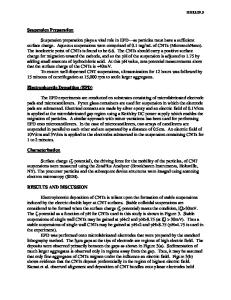An extensive study on carbon nanomaterials electrode from electrophoretic deposition technique for energy storage device
- PDF / 466,510 Bytes
- 11 Pages / 584.957 x 782.986 pts Page_size
- 51 Downloads / 375 Views
The development of energy storage device utilizing carbon nanomaterials possesses remarkably significant electrochemical performance. As compared to others, carbon nanomaterials including carbon black, graphene, activated carbon, and carbon nanotube have advantages in ion accessibility and specific surface area in which, more charged ions can access and transfer to the surfaces of material and thus have enhanced electrical charge storage performance. This manuscript briefly reviews the deposition of carbon nanomaterials from electrophoretic deposition technique which is good because of its simple, economical, versatility, and possibility of the thin film deposition on large substrate. The current state-of-the-art and performance of devices employing carbon as electrode material is also extensively discussed. I. INTRODUCTION
Recently, global concerns in climate changes and the reduced amount of fossil fuel causes an ultimate focus toward the investigation and development of the alternative renewable energy resources. Compared with natural resources, such as sun, water, wind etc., electrical energy storage systems have a huge impact on our daily lives due to their availability on demand and usage. Battery and electrochemical capacitor (EC) are among the energy storage systems, which have the capability of delivering a large amount of energy in a short response.1–3 Compared to battery, EC has several advantages such as high power density, fast charge/discharge response, long cycle life, and high cycle efficiency.4–6 In this case, EC has already been considered as the solution to the instability of the battery to discharge efficiently at high rates and at the same time as the power requirement of the device.7,8 Carbon materials have been considered as a promising advanced electrode material for EC and/or battery because of their low cost, high specific surface area, and excellent capacitive performance in the aqueous electrolytes.9–11 Nanostructured mesoporous carbon has been used as negative electrode of rechargeable lithium batteries12 and as active materials for EC electrodes.13–15 The performances of EC electrodes and/or battery were negatively influenced by mass transport constraints due to the small ion mobility and transfer of the electrolyte into the carbon pores. For example, carbons with a higher fraction of mesopores supplied higher current densities and determined
Contributing Editor: Mohd Fadzli Bin Abdollah a) Address all correspondence to this author. e-mail: [email protected] DOI: 10.1557/jmr.2016.88
a smaller time constant with respect to mainly microporous carbons.16 Besides, the use of carbon with existing mesoporosity in the electrodes admitted the improvement of the specific capacitance of carbon-based supercapacitors.17 Moreover, Markoulidis et al.18 compared the different carbons of different pore size distributions and with comparable specific surface areas and determined that those were mostly mesoporous and had a higher capacitance. Impressive progress has been achieved in the deposition of carbon m
Data Loading...











